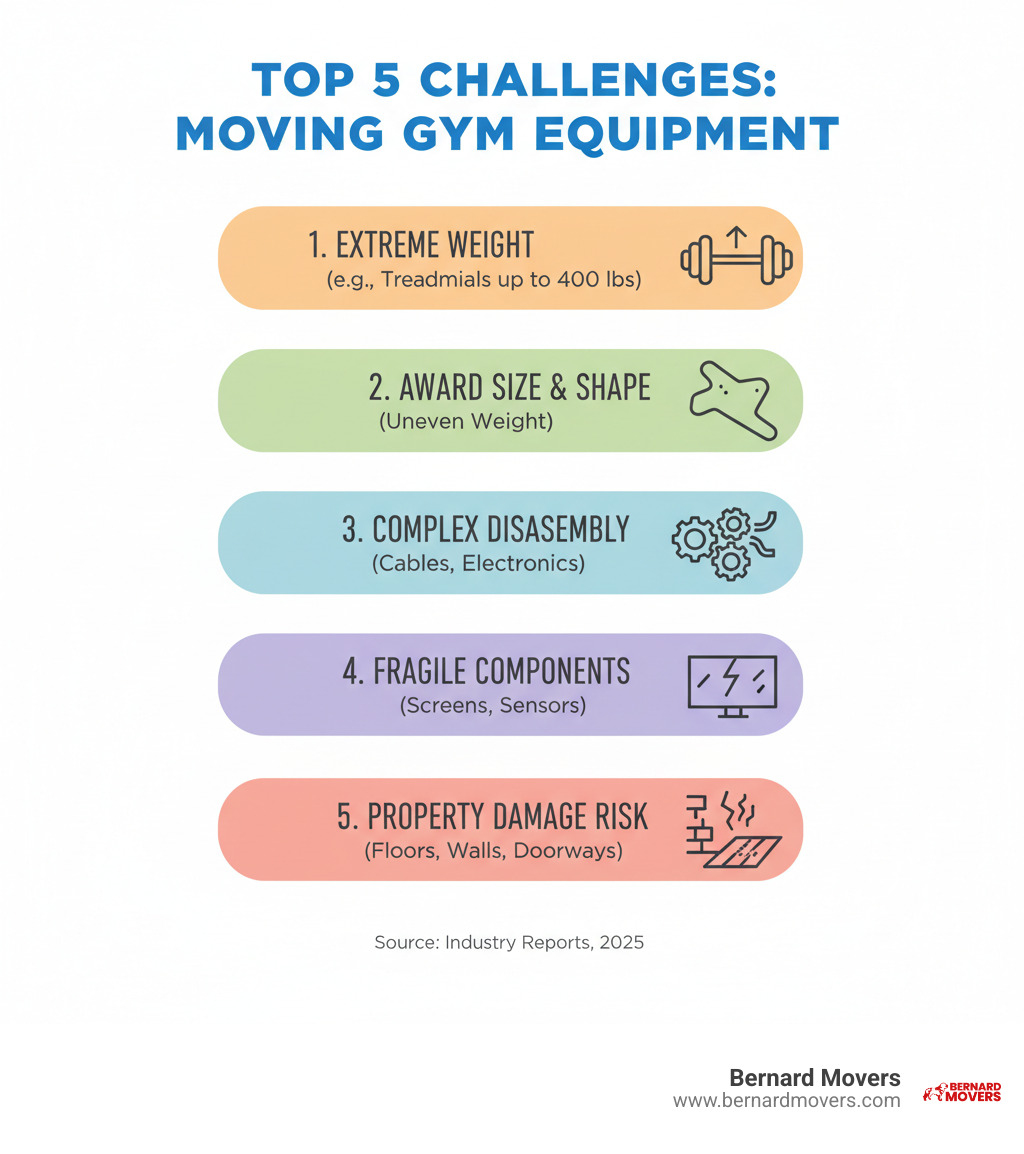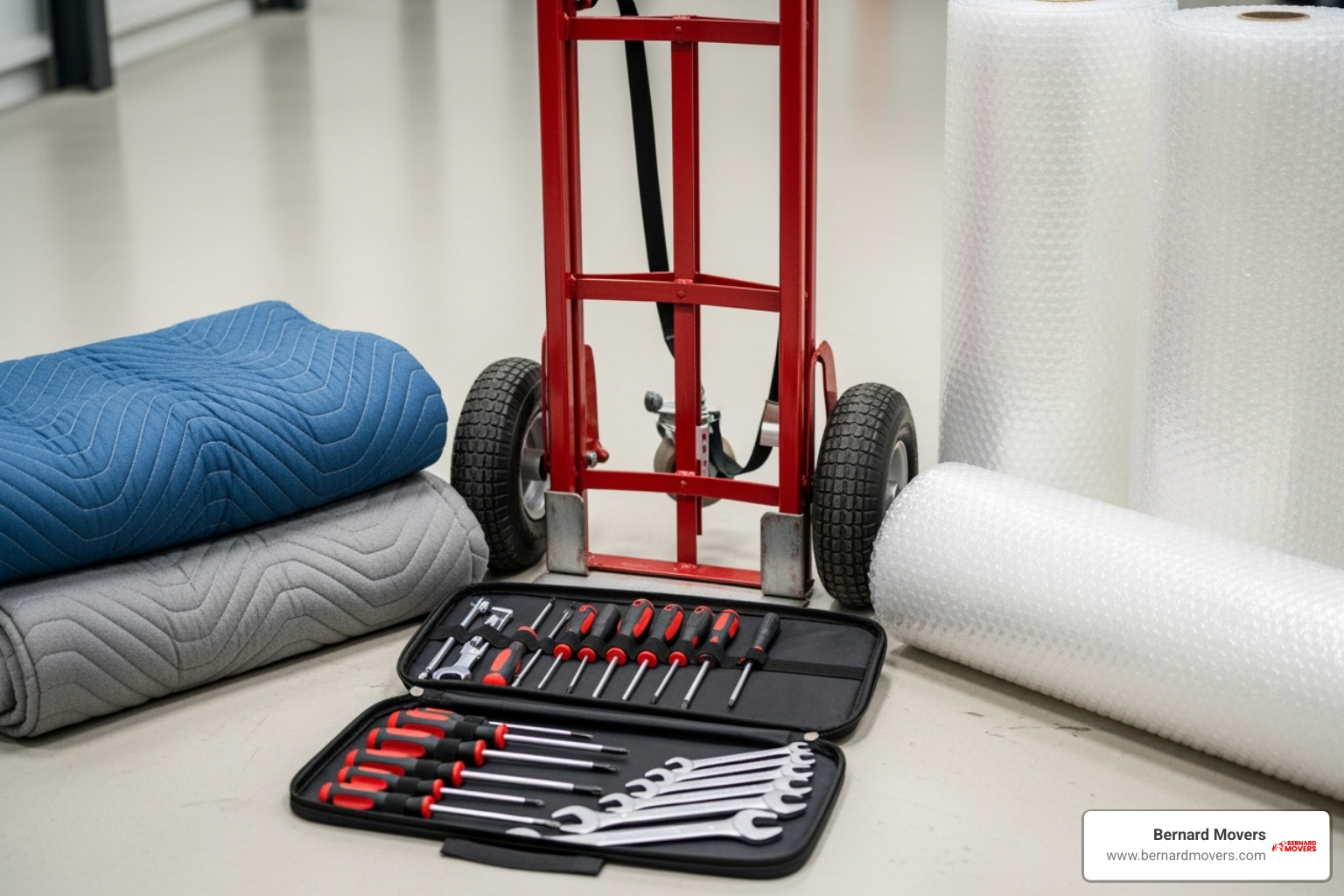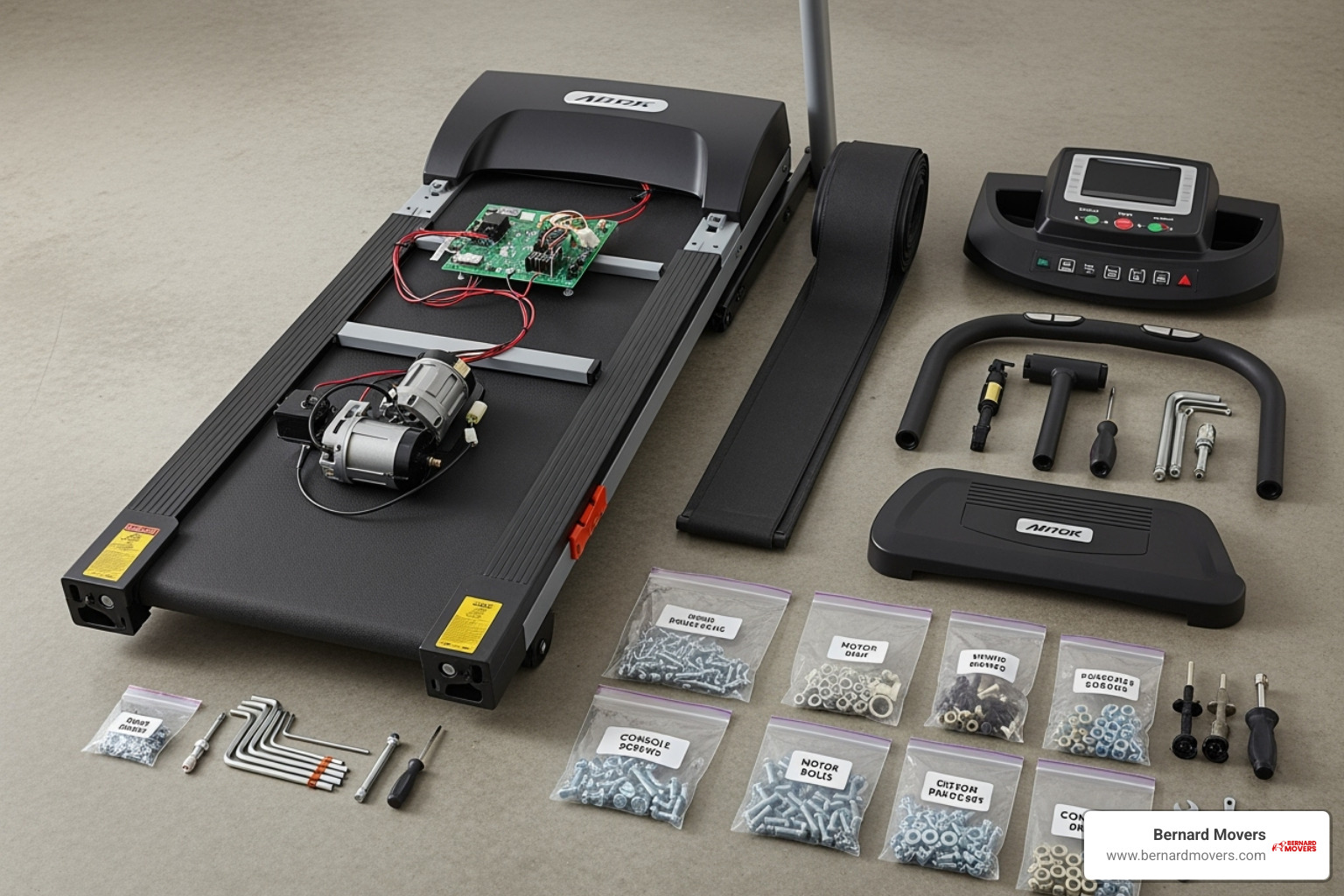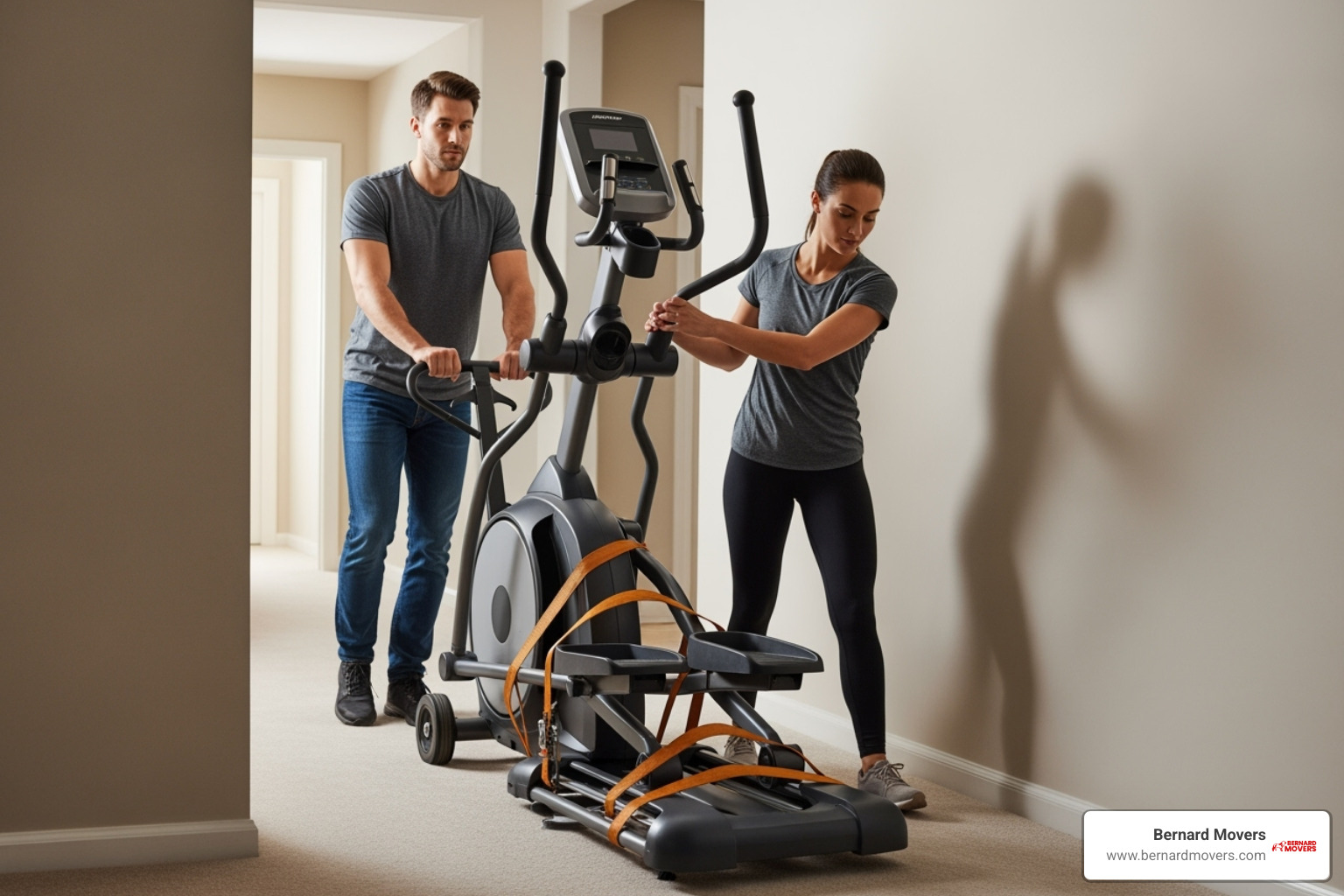Moving workout equipment: 5 Expert Tips for a Smooth Move
Your Game Plan for a Smooth Move
Moving workout equipment is a major challenge during relocation. According to a June 2023 survey, around 40% of Americans own or have access to home exercise equipment, making this a common concern for families across Chicago and beyond.
Quick Answer for Moving Workout Equipment:
- Prepare: Clean equipment, create inventory, gather tools (dollies, straps, blankets)
- Disassemble: Take photos, label parts, store hardware in bags
- Pack Safely: Use sturdy boxes for weights, wrap machines in blankets
- Move Smart: Lift with legs, use dollies, get help for heavy items
- Protect: Use floor runners and wall padding to prevent damage
Gym equipment presents unique challenges. Machines often have awkward shapes and uneven weight distribution, making them hard to handle. A high-end treadmill can weigh 400 pounds, and even dumbbells require special packing to prevent injury or property damage.
Whether it’s a home gym in a Chicago apartment or a fitness facility in Melrose Park, the stakes are high. Improper handling can lead to costly equipment damage, personal injury, or harm to your property.
As Mina Georgalas, owner of Bernard Movers with nearly 30 years of experience, I’ve seen how planning prevents disaster when moving workout equipment. Our team has helped countless Illinois families and businesses safely transport everything from basic weight sets to complex commercial gym installations.

Key terms for Moving workout equipment:
Your Step-by-Step Guide to Moving Workout Equipment
Moving workout equipment doesn’t have to feel like a personal record deadlift. With the right game plan, you can get your fitness gear safely to its new home without injury or property damage. Let’s walk through this process one phase at a time.
Phase 1: Preparation and Planning
This phase is like a pre-workout warm-upessential for preventing injury and ensuring a smooth move.

Start by taking inventory of everything. Your home gym likely has cardio equipment (treadmills, ellipticals), strength gear (weight benches, free weights), and accessories. Each type has unique challenges; a 400-pound treadmill moves differently than a dumbbell set.
Create a detailed list of each item, noting its condition and deciding what’s worth moving versus selling or donating.
Find your owner’s manuals. They contain specific disassembly instructions that will save you hours of frustration, especially with complex multi-station gyms.
Clean all equipment before packing to avoid transferring dirt and grime to your new Chicago apartment or other belongings.
Measure every doorway, hallway, and stairwell at both locations. An elliptical that fits in your current basement might not make it up the stairs in your new Melrose Park home. Plan your route in both properties, noting any obstacles.
Gather your supplies. You’ll need a moving dolly, moving straps, furniture sliders, moving blankets, bubble wrap, sturdy small boxes, zip-top bags for hardware, and a complete toolkit. Don’t forget floor runners to protect your floors.
Phase 2: Packing and Disassembly
Taking your time here will save you major headaches later.

Before disassembly, take photos or videos of how everything connects. These visual guides are lifesavers during reassembly.
Follow the owner’s manual for disassembly. Manufacturers know the safest way to take their equipment apart. Label every part as it comes off (e.g., “Left Treadmill Arm”). Store all hardware in clearly labeled zip-top bags. Place a label inside the bag, as outside labels can get damaged.
Pack free weights carefully. Wrap dumbbells and kettlebells individually and place them in small, reinforced boxes. Keep boxes at a liftable weight to prevent injury and box failure. Pack weight plates vertically in sturdy boxes, wrapping each one.
Cardio machines need special care for their electronics and moving parts. For treadmills, fold and secure the deck if possible. For ellipticals and bikes, remove pedals, handlebars, and consoles to make them more manageable. Home gym systems are the most complex; take extra photos, remove weight stacks and cables, and label everything carefully.
Wrap all items in moving blankets secured with stretch wrap. Use cardboard to protect chrome surfaces. Protect floors and walls with runners and blankets over doorframes.
For more detailed guidance, check out our specialized tips for Moving Heavy Gym Equipment.
Phase 3: Safe Lifting and Transportation
Now it’s time to move your gear safely.

Proper lifting technique is non-negotiable. Lift with your legs, not your back. Keep your spine straight, the load close to your body, and pivot with your feet instead of twisting. For an overview of safe handling basics, review Manual handling of loads.
Never move heavy gym equipment alone. The awkward shapes make solo moves dangerous, even if you’re strong. It’s about safety, not weakness.
Use dollies and furniture sliders. Secure items on dollies with moving straps. Use sliders for items that won’t fit on a dolly to protect floors.
Stairs in Chicago’s walk-ups require extra caution. Use a stair dolly and have multiple people to guide and support the weight. For the heaviest items on stairs, professional help is essential.
In the truck, secure items to prevent damage. Load heavy items first at the front. Use tie-down straps and place moving blankets between items to prevent scratches.
Whether you’re moving across Chicago or to a new state, these techniques will help protect your investment. For additional strategies, explore our comprehensive guide with more expert tips for moving gym equipment.
Advanced Logistics and Making the Right Call
DIY vs. Hiring Professional Movers
Facing a 400-pound treadmill in your Chicago apartment raises the question: DIY or hire professionals? The decision isn’t just about cost.
DIY might seem cheaper, but hidden costs add up: renting special equipment, buying supplies, and potential repair bills for damaged items or property. Plus, there’s the risk of personal injury.
Most people underestimate the complexity. A weight bench can easily damage walls in a tight Melrose Park walkup. The risk of injury from improper lifting or dropping heavy items is significant.
Professional movers bring best expertise. We’ve moved thousands of fitness items across Illinois and know how to disassemble complex gyms safely. Our teams have the right tools and training.
| Aspect | DIY Moving | Professional Movers |
|---|---|---|
| Cost | Lower upfront, hidden costs add up | Higher upfront, often more cost-effective overall |
| Time | Very time-consuming, multiple trips | Efficient, completed in one day |
| Safety | High injury risk, no training | Trained professionals, proper equipment |
| Equipment Damage | Higher risk of scratches and malfunctions | Expert handling, lower damage risk |
| Property Damage | Risk to floors, walls, doorways | Protective measures, careful handling |
| Insurance | Your responsibility if something breaks | Coverage options available |
Our knowledge of the Illinois area, from cramped Chicago apartments to suburban homes, adds value. We know how to steer the narrow hallways and steep staircases common in the region.
For peace of mind, consider our comprehensive Fitness Equipment Movers services.
Common Mistakes to Avoid
We’ve seen these preventable mistakes countless times when moving workout equipment.
- Improper Lifting: Lifting with your back instead of your legs is a common mistake that leads to injury. Always use proper form.
- Forgetting to Measure: It’s frustrating to find your equipment won’t fit through a doorway. Measure all paths at both locations before you start.
- Losing Hardware: It’s easy to lose small bolts and screws. Use labeled bags for all hardware to save time and frustration during reassembly.
- Damaging Property: Forgetting to protect floors and walls can lead to costly repairs. Use sliders, runners, and blankets.
- Rushing: Rushing leads to accidents. Take your time to ensure a safe move for yourself and your equipment.
- Overloading Boxes: Packing too many weights into one box creates an injury risk and can cause the box to fail. Use small, sturdy boxes and keep them at a manageable weight.
For more guidance on avoiding these pitfalls, check out our Exercise Equipment Moving page.
Special Considerations for Moving Workout Equipment
Home vs. Commercial Gyms: Moving a personal home gym in Chicago is different from relocating a commercial facility. A home move involves fewer items and more flexible timing. Relocating a commercial gym in Melrose Park involves dozens of machines and tight deadlines to minimize business downtime. Our commercial teams create flawless logistics plans to get businesses running again quickly.
Post-Move Reassembly: After the move, reassembly requires patience. Use your photos and labeled bags. Test all equipment thoroughly for any issues before your first workout.
Cost Factors: Several factors influence your moving cost. The biggest is the type and complexity of your equipment. Distance is another factor; local Chicago moves are often hourly, while long-distance moves (like our discounted moves to Georgia or Florida) are based on weight and mileage. Accessibility at your locations, such as stairs or tight corners, adds complexity and cost. The number of movers needed also affects the price, as heavy items require a larger team for safety.
For complex commercial moves or challenging residential situations in Illinois, Bernard Movers has the expertise you need. Remember our 20% additional discount on moves to Georgia or Florida booked for delivery by March 15, 2025. For more information about our specialized commercial services, visit our Commercial Exercise Equipment Movers page.
Ready to make your move stress-free? Contact our expert fitness equipment movers today for a consultation custom to your specific needs.